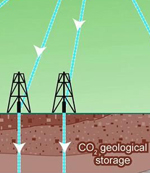
The idea to sequester carbon is gaining support as a way to avoid global warming. For example, the European Union plans to invest billions of Euros within the next ten years to develop carbon capture and storage whereby CO2 will be extracted at power plants and other combustion sites and stored underground.
But how effective is this procedure and what are the long-term consequences of leakage for the oceans and climate? A Niels Bohr Institute researcher has now cast light upon these issues. This research has just been published in the scientific journal, Nature Geoscience.
Large scale use of carbon sequestration could help to avoid extreme global warming that would otherwise occur in the near future unless fossil fuel emissions are reduced significantly. But it is not clear how effective different types of sequestration are in the long run, owing to leakage of stored CO2 back out to the atmosphere. Nor is it clear what would be the long-term consequences of such leakage for the Earth’s environment.
Gary Shaffer, professor at the Niels Bohr Institute, and leader of the Danish Center for Earth System Science, made long model projections for a number of sequestration/leakage scenarios. His results show that leakage of the stored CO2 may bring about large atmosphere warming, large sea level rise and oxygen depletion, acidification and elevated CO2 concentrations in the ocean.
Storage of CO2 in the deep ocean is a poor choice since this creates grave problems for deep sea life and since CO2 stored this way returns to the atmosphere relatively quickly, bringing back the global warming.
Geological storage may be more effective in delaying the return of the warming and associated consequences but only if a CO2 leakage of 1 % or less per thousand years can be obtained.
A burden for future society
Alternatively, one could actively counter leakage from the ocean or geological reservoirs by re-sequestering CO2 to stabilize climate at some desired level. But it would be hard to gauge the global leakage rate to be matched by re-sequestration. Furthermore, re-sequestration would have to be carried out over many thousands of years, a burden for future society in line with that of long term management of nuclear waste.
“CO2 sequestration has many potential advantages over other forms of climate geoengineering. It makes good sense to modify the Earth’s radiation balance by putting carbon back in where it came from. Atmospheric CO2 is long-lived and evenly-distributed globally making it possible to manage it in a long-term, controlled way with less chance for unpleasant climate surprises. However, one should not underestimate potential short and long-term problems with leakage from underground reservoirs. Carbon in light form will seek its way out of the ground or seabed. The present situation in the Gulf of Mexico is a poignant reminder of that”, says Gary Shaffer.
Professor Shaffer concludes that “the dangers of carbon sequestration are real and the development of this technique should not be used as an argument for continued high fossil fuel emissions. On the contrary, we should greatly limit CO2 emissions in our time to reduce the need for massive carbon sequestration and thus reduce unwanted consequences and burdens over many future generations from the leakage of sequestered CO2.”
Source University of Copenhagen



